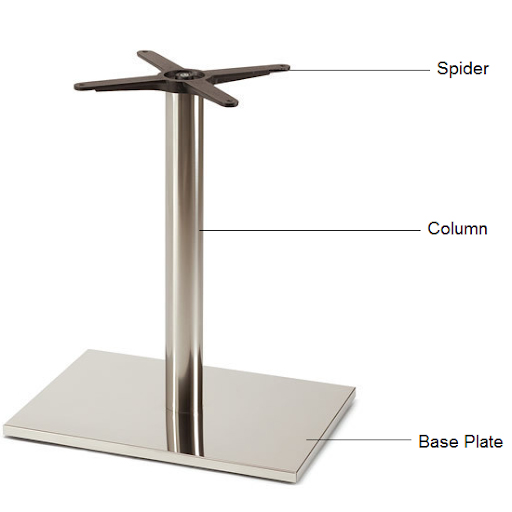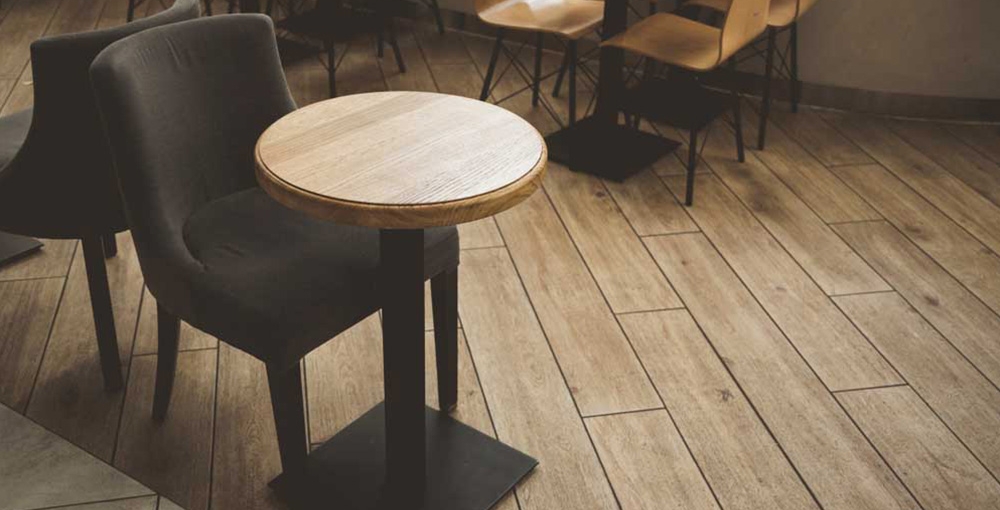When deciding on design aesthetics for your restaurant or bar, choosing the right table base may not be the first thing that comes to mind, yet it’s incredibly important. Table bases are the root of your aesthetic, and they should complement your style in both form and function. To help you choose the right base for your space, we’ve gathered six of the most common questions restaurant owners have about pedestal table bases.
Are pedestal bases a good option?
By and large, the most common table base used in the hospitality industry is the pedestal table base. Pedestals are available in a variety of styles, sizes, materials, and finishes. They are convenient for customers as there are no legs on the outer edge of the table to get in the way. Employees like the fact that they are much easier to move than four-legged tables and less likely to get damaged in the moving process.
What material is better for indoor/outdoor use?
In general metal pedestal bases work well in an outdoor environment. Bases made from aluminum, galvanized steel, or stainless steel should hold up to prolonged exposure to the elements. If you have your heart set on iron table bases, you can use them, but you need to have them treated with a protective coating to avoid corrosion.
If you prefer the warmth of wood in your outdoor space, look for pedestal bases made of teak or cedar, both which can withstand repeated exposure to outdoor elements.
Regardless of what material you choose, it’s important to make sure table bases that will be used outdoors are heavy enough to stand up to windy conditions.
For indoor tables, the sky really is the limit. Choose the material and finish that best compliments the décor of your restaurant.
What are the main parts of a pedestal base?

All pedestal bases have 3 components: the spider (onto which the tabletop affixes), the column, and the base.
The pedestal base should be large enough to support your tabletop, but not so big that it gets in the way of your guests’ feet. It’s also important to verify the base you’re considering is strong enough to hold the weight of your tabletop, particularly if your tops are made of granite, marble, or some other heavy material.
The column on a pedestal base may be round or square. Regardless of shape, make sure the column is not flimsy…after all it is what keeps your table standing and now is not the time to try to save money by purchasing cheaply made versions. Look for bases with a column that is a minimum of 76mm in diameter or 80 x 80mm square. If you plan to purchase very heavy tabletops, you will need to purchase bases with a wider column or double columns.
The spider is the cross plate at the top of the pedestal base that affixes to the tabletop.
I have already purchased chairs. Does this affect what pedestal base I should purchase?
The answer is…absolutely! For traditional seating, most tables should reach a height of 740 – 780mm, leaving diners with enough room to comfortably cross their legs. Aim to leave 250 – 300mm of space between the bottom of your tabletop and the top of your chair seat to keep guests comfortable.
If you have bar stool chairs, the height from floor to tabletop should be 1100mm.
Which finish should I choose for a pedestal base?
This depends on the aesthetic of your establishment. Most metal bases are left in their natural state, but many can be painted to blend in with your current décor.
Black is always a safe bet in terms of color because it allows the pedestal to blend seamlessly with any design style and won’t detract from the lovely tablescape you’ve created.
If you prefer a metallic finish, you can’t go wrong with chrome which is quite popular in restaurants wanting a more modern or industrial feel.
If you are going with a wooden pedestal base, there’s no limit to your options as most wood can be stained to achieve the color of your choosing.
What about the dreaded wobbly table? How do I avoid that problem with my pedestal base?
Ugh. We’ve all been there. There is nothing worse than sitting down for a nice meal only to realize your table is unstable. There are several reasons this scenario can happen, including:
- The tabletop has come loose from the pedestal base
- The floor itself is uneven
- The base has not been assembled properly
- The base is too small for the tabletop
Many pedestal bases come with levelers or adjustable feet on the base that allow you to modify how the base hits the floor. If your business has an area with very uneven flooring, you may want to consider reconfiguring your dining area, so tables are not placed in the uneven spots. Another option is to purchase table shims at your local commercial furniture store or online. These can be used to stabilise tables and look decidedly better than the folded napkins that are often used out of desperation.
When it comes time to update your table bases, check out our online selection or visit our showroom and let our team of hospitality experts help you choose the perfect base for your business.

